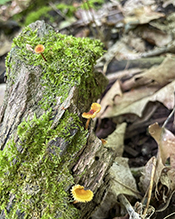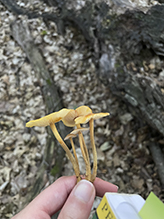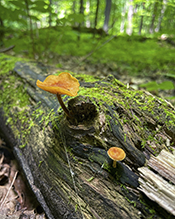Orange Faint Foot Mushroom
(Heimiomyces tenuipes)
Conservation • Description • Habitat • Ecology • Distribution • Taxonomy
Conservation Status |
|
|||||||
| IUCN Red List | not listed |
|||||||
| NatureServe | NNR - Unranked |
|||||||
| Minnesota | not listed |
|||||||
Description |
||
Orange Faint Foot Mushroom is a small to medium-sized gilled mushroom. It occurs in North America, South America, the Caribbean region, Africa, southeast Asia, Australia, and New Zealand. In the United States it occurs east of the Great Plains. In Minnesota it occurs in the southeast quarter of the state. It is found in late spring and early summer, alone, scattered, or in groups but not clustered (gregarious). It grows on dead hardwood, including fallen logs. It also grows on the ground next to fallen logs and on the debris of dead hardwood. It obtains its nutrients from dead wood (saprobic). When it first appears the cap is convex, moist, dark orangish-brown to orangish-brown in the center, and brownish-orange to yellowish-orange near the margins. It is densely covered with fine, matted, velvety hairs. As it ages the cap flattens out with the margins curved downward. Mature caps are ⅝″ to 3⅛″ (16 to 80 mm) in diameter, the margins are lined (striate) and uplifted, and the upper surface is sometimes nearly hairless. The tissue of the cap is normally opaque but becomes somewhat transparent as it absorbs water. The stalk is tough, pliable, hollow, dry, ¾″ to 3″ (20 to 75 mm) long, and 1⁄16″ to ⅜″ (2 to 10 mm) thick. It has an enlarged base but is otherwise the same size from top to bottom. It is round in cross section at first but becomes compressed or split at maturity. The surface is brownish-orange above, brown to dark brown below, and densely covered with fine, almost velvety hairs. The gills are whitish to yellowish, closely spaced, and often forked. They are notched or broadly attached where they attach to the stalk and there is a thin tooth that extends down the stalk. There are abundant cross-veins near the margin of the cap that connect adjacent gills together. This is a distinguishing feature of the genus Heimiomyces and its former genus Xeromphalina. Between the main gills there are two or three short gills that attach to the margin but do not extend all the way to the stalk. The flesh is thin and orangish-brown. The edibility is unknown, but the rubbery texture makes it unpalatable. The spore print is white. |
||
Similar Species |
||
Habitat and Hosts |
||
Dead hardwood |
||
Ecology |
||
Season |
||
Late spring and early summer |
||
Distribution |
||||
|
Sources |
|||
| 11/16/2022 | ||||
Occurrence |
||||
|
||||
Taxonomy |
|||
| Kingdom | Fungi (Fungi) | ||
| Subkingdom | Dikarya | ||
| Phylum | Basidiomycota (Basidiomycete Fungi) | ||
| Subphylum | Agaricomycotina (Higher Basidiomycetes) | ||
| Class | Agaricomycetes (Mushrooms, Bracket Fungi, Puffballs, and Allies) | ||
| Subclass | Agaricomycetidae | ||
| Order | Agaricales (Common Gilled Mushrooms and Allies) | ||
| Suborder | Marasmiineae | ||
Family |
Mycenaceae | ||
Genus |
Heimiomyces | ||
This fungus was formerly classified as Xeromphalina tenuipes and included in the Heimiomyces section of the genus Xeromphalina. In a recent article (Desjardin & Perry 2017. The gymnopoid fungi (Basidiomycota, Agaricales ) from the Republic of São Tomé and Príncipe, West Africa.) the authors suggested moving it to the genus Heimiomyces based on unpublished molecular data. MycoBank, iNaturalist, and NCBI are among the few sources that have followed this recommendation and use the name Heimiomyces tenuipes. Most sources, including Index Fungorum and GBIF, continue to use the name Xeromphalina tenuipes. |
|||
Synonyms |
|||
Agaricus tenuipes Agaricus rheicolor Collybia tenuipes Collybia rheicolor Gymnopus tenuipes Gymnopus rheicolor Heimiomyces rheicolor Xeromphalina tenuipes |
|||
Common Names |
|||
Orange Faint Foot Mushroom |
|||
Glossary
Saprobic
A term often used for saprotrophic fungi. Referring to fungi that obtain their nutrients from decayed organic matter.
Visitor Photos |
|||||
Share your photo of this fungus. |
|||||
| This button not working for you? Simply email us at info@MinnesotaSeasons.com. Attach one or more photos and, if you like, a caption. |
|||||
Honey Fae (Farah) |
|||||
 |
 |
||||
 |
|||||
MinnesotaSeasons.com Photos |
|||||
|
|||||

Slideshows |
||

Visitor Videos |
|||
Share your video of this fungus. |
|||
| This button not working for you? Simply email us at info@MinnesotaSeasons.com. Attach a video, a YouTube link, or a cloud storage link. |
|||
Other Videos |
|||

Visitor Sightings |
|||||
Report a sighting of this fungus. |
|||||
| This button not working for you? Simply email us at info@MinnesotaSeasons.com. Be sure to include a location. |
|||||
| Honey Fae (Farah) 7/9/2022 |
Location: Hennepin County |
||||
| Honey Fae (Farah) 6/2022 |
Location: Hennepin County |
||||
| Honey Fae (Farah) 5/2021 |
Location: Hennepin County |
||||
MinnesotaSeasons.com Sightings |
|||||
|
|||||

Created: 11/16/2022
Last Updated:



